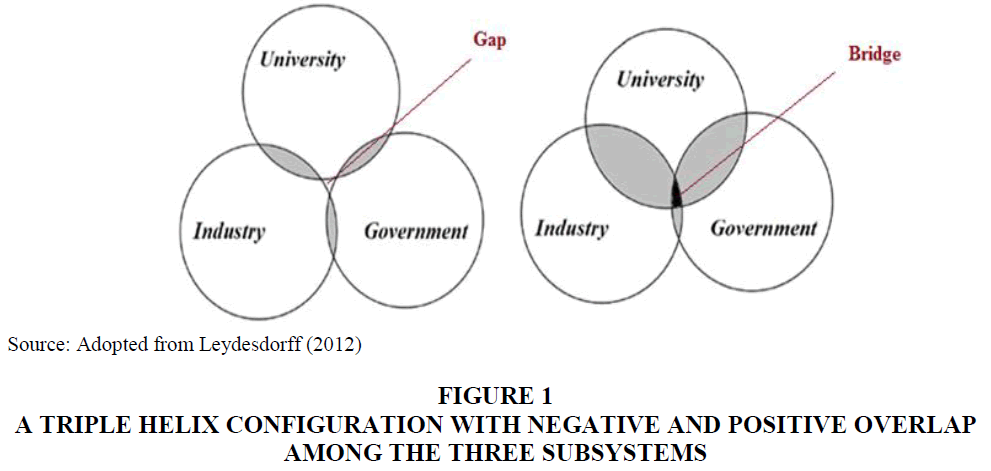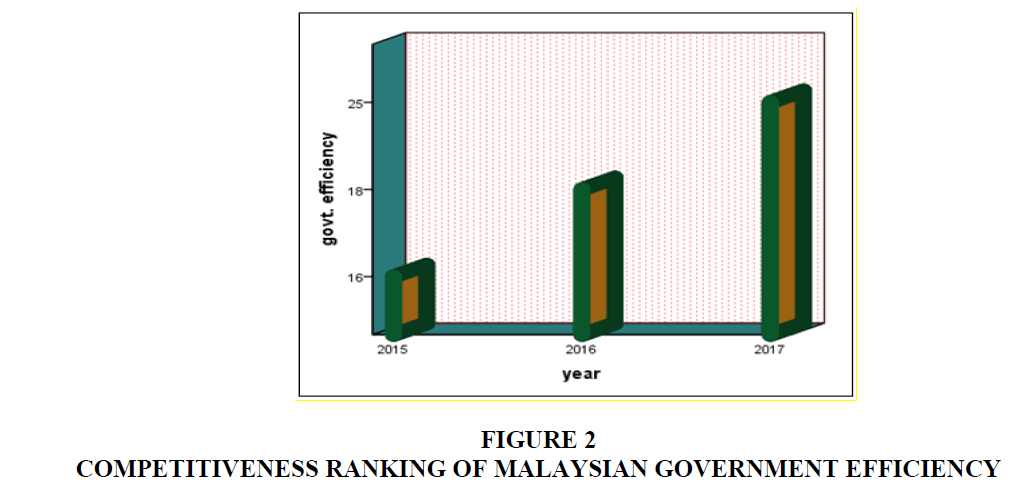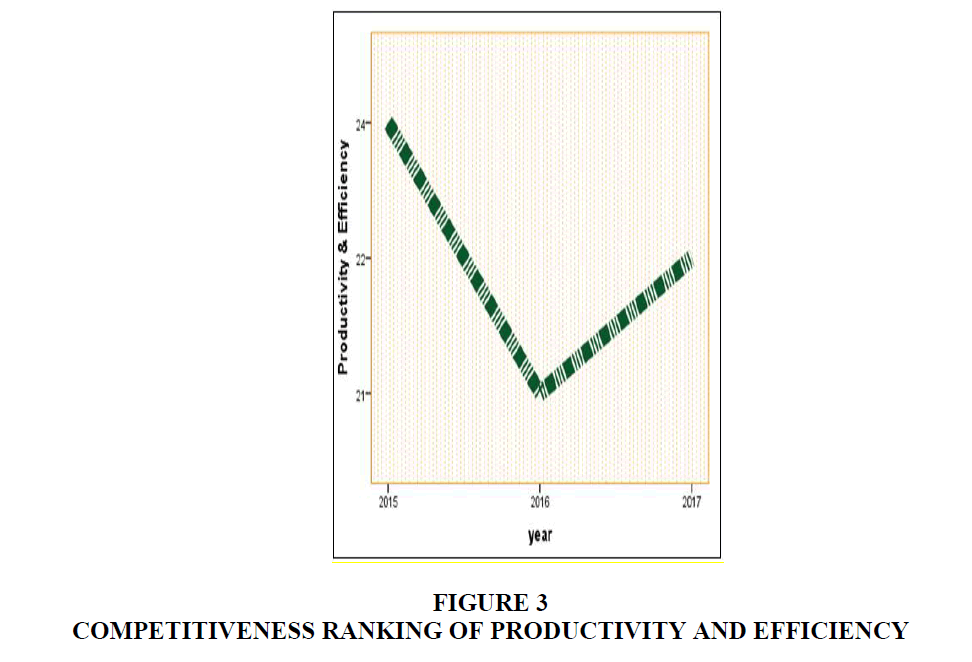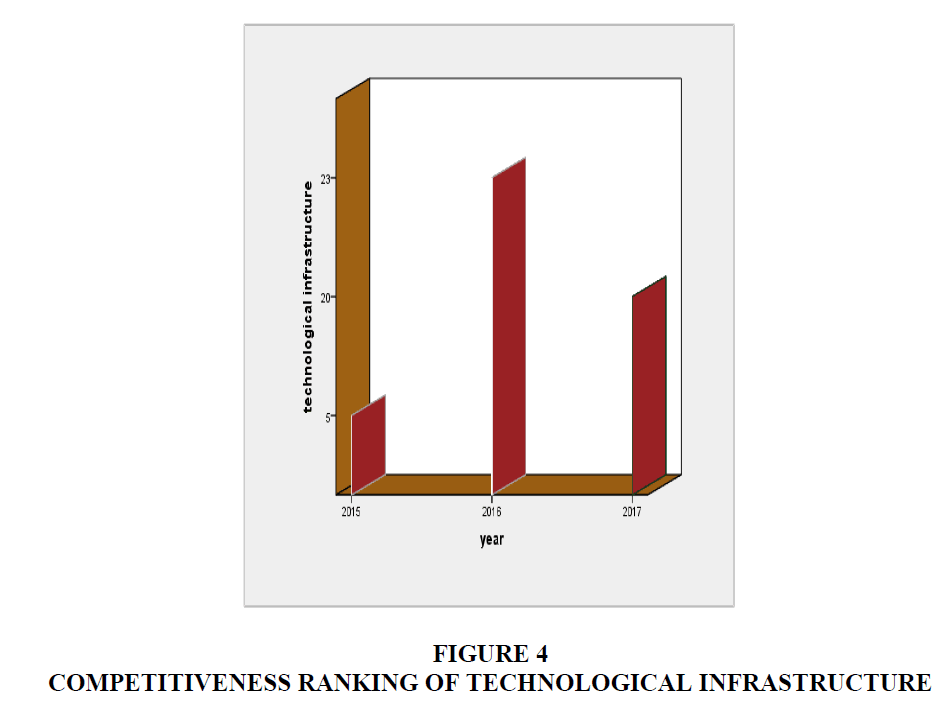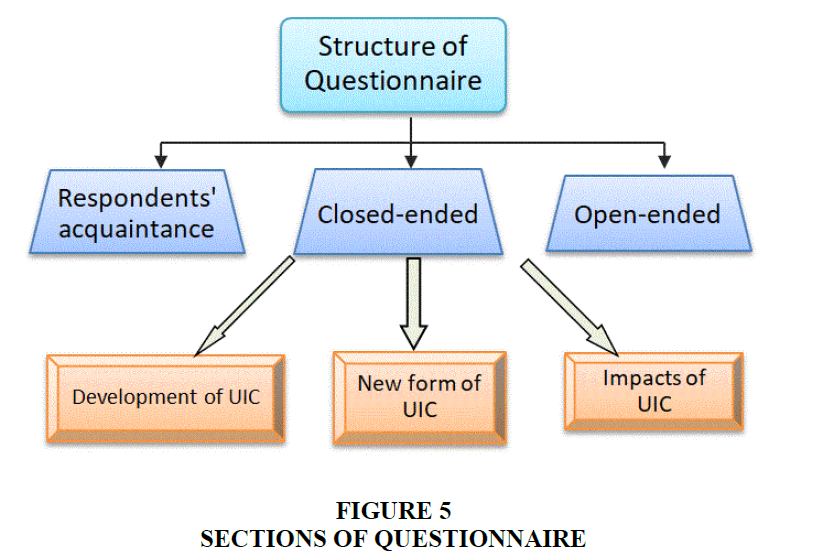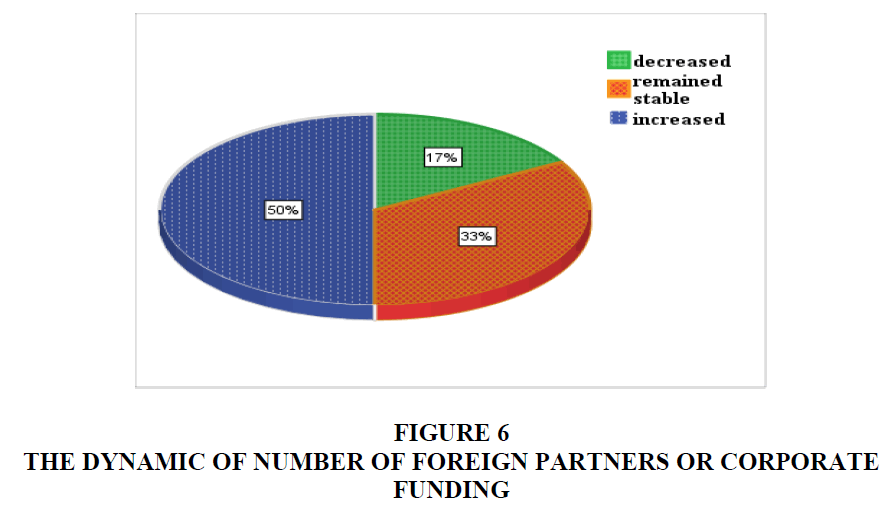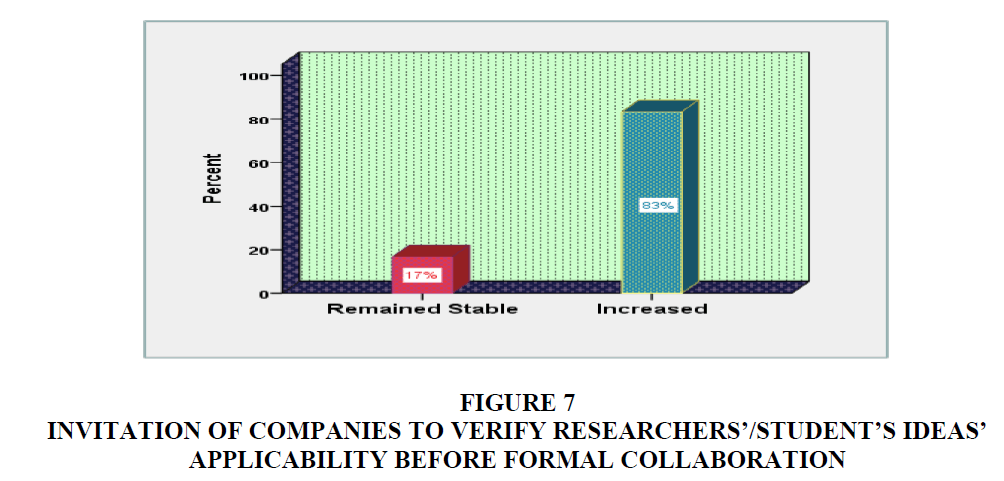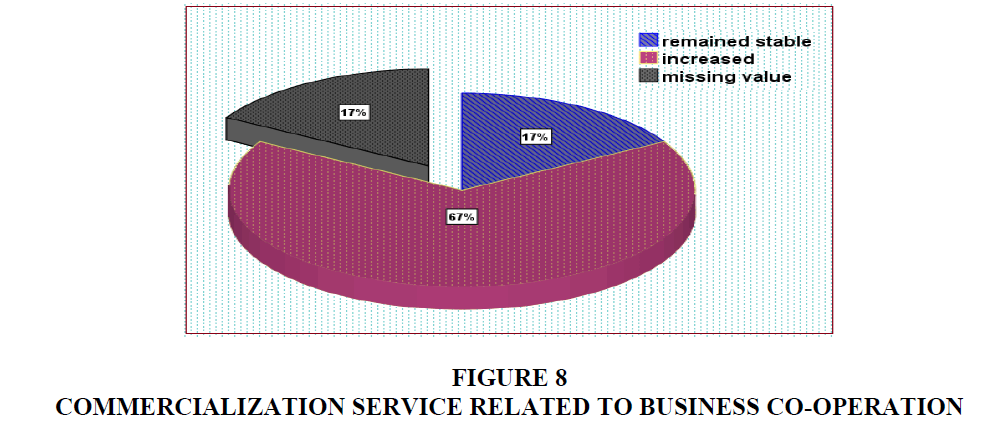Research Article: 2018 Vol: 21 Issue: 2
An Investigation on Triple Helix Model and National Innovation Systems: The Case of Malaysia
Munshi Naser Ibne Afzal, University Malaysia Sabah (UMS)
Rini Suryati Sulong, University Malaysia Sabah (UMS)
Susmita Dutta, Shahjalal University of Science and Technology (SUST)
Datuk Kasim Bin HJ MD. Mansur, University Malaysia Sabah (UMS)
Abstract
The Triple Helix (TH) model (University-Industry-Government relationship) enables numerous nations to enhance and accelerate their development forms. Ventures and universities are customary wellsprings of information. In most creating nations like Malaysia, which is experiencing significant change towards innovation-based economies, the Triple Helix model coupled with the National Innovation System can speed up this progress. This paper investigates the application of the Triple Helix (TH) model inside the National Innovation System in Malaysia. It looks at the degree or level of cooperation amongst organizations and universities in advancing economic development. This research applies mix method in which an integrative investigation of the literature, secondary information and a survey of six Malaysian public universities. The outcomes demonstrate that, the application of Triple Helix model in Malaysian public universities is acceptable. The National University of Malaysia (UKM) performed poorly while University Putra Malaysia (UPM) appears better than others. The outcomes show the need of taking care of distinguished issues in parallel with the execution of the open development idea to extend University-Industry-Government collaboration.
Keywords
Triple Helix, Entrepreneurial University, National Innovation Systems, Malaysian Public University, Research Product Commercialization.
Introduction
Application of new information and technologies and incorporate them into individuals as well as organizations have turned out to be progressively critical for entrepreneurship (Friedman, 2007). In this regard, universities in a country are helping entrepreneurial activities by setting up spin-offs firms (Swamidass & Vulasa, 2008), technology transfer office (Harman & Harman, 2004) along with initial goal of knowledge creation (Etzkowitz, 2003).
In this study, this connection is examined by applying the Triple Helix model (University-Industry-Government relationship) with regards to selected Malaysian public universities. The Malaysian government has been progressively positioned around sustaining university innovation- industry connections and government involvement.
There is a gap in literature to discover how this cooperation happens in particularly Malaysia, all things considered, circumstance and where the exploration universities remain in contrast with their joint effort execution. Consequently, the main goal of this research is to comprehend the connection between the National Innovation System (NIS) and Triple Helix Model (TH) theoretically and hence seek empirical evidence. In the period of innovation driven transformation, each nation needs to enhance its economic development through innovation or technology transfer. Thinking about economic, social and political condition, every nation has its own particular development roadmap. Thus, this research analyses the analytical framework of TH model in context of Malaysia.
Our research questions are:
1. RQ-1: What is the effect of Triple Helix on Malaysian NIS?
2. RQ-2: Which type of University-Industry coordinated effort exists in Malaysia?
3. Research sub-questions:
4. RSQ-2.1: Does the reverse direction (Industry-University) of knowledge transfer exist and if yes, how is it implemented?
5. RSQ-2.2: What is the inspiration of each side to start cooperation?
6. RSQ-2.3: What are the key issues of University-Industry Collaboration with regards to Malaysia?
7. RSQ-2.4: Which arrangements could better address these issues?
Research Design
The research design is based on literature review, secondary data, survey and interview results. Following the characterization of research techniques given by Saunders et al. (2009), this study is considered to be recognized as quantitative, in light of the fact that it is mostly in view of survey investigation and presented by diagrams. To begin with, the literature identified with University-Industry cooperation and National Innovation System (NIS) is outlined following case studies of selected public universities in Malaysia. Subsequently, it demonstrates the state of Malaysian government activities in promoting TH model using secondary data of World Competitiveness Yearbook 2017. Accordingly, based on the need of the investigation, a survey had been conducted and information was gathered from selected Malaysian public universities during May to July 2017. Finally, the organized email meets with a specialist in University-Industry joint effort in Malaysia was directed. This investigation recognizes the specialists toward the finish of the article.
Literature Review
This segment has two sections, theoretical background of NIS and TH model and it discourses of these in the context of Malaysia.
National Innovation Systems (NIS)
Freeman (1987), Dosi et al. (1988), Lundvall (1992), Nelson (1993) and Edquist (1997) give a diagnostic structure which relates innovation and learning with economic development and welfare, which is known as National Innovation Systems (NIS). The centre of this framework is firms and their channels of obtaining outside wellsprings of learning, which can be different firms, investigation foundations or the scholarly world in provincial, national or worldwide. NIS incorporates joint industry exercises; open/private associations like joint research exercises, co-licenses and co-distributions, reference investigation, firm reviews; innovation dispersion, work force portability.
Lundvall (1992) has defined national innovation systems as
…the elements and relationships which interact in the production, diffusion and use of new and economically useful, knowledge…and are either located within or rooted inside the borders of a nation state.
In actuality, there are two sorts of results, innovation (new/enhanced item and process, enhanced association) and economic execution (enhanced efficiency and upgraded benefits), though innovation impacts economic execution (Afzal and Lawrey, 2012; 2014).
Bartels et al. (2012) give a model of NIS behavioral elements in view of determinants of NIS conduct. Creators locate that auxiliary elements of information administration, basic leadership, government-business relations and the market are imperative to NIS conduct. They prescribe to the creating nations to centre around building up an institutional situation to help such markets and market exchanges that help the local NIS and economic development a while later. Castellacci and Natera (2013) found long haul co-evolution between innovative ability and absorptive limit, which drives the elements of NIS.
Triple Helix (TH) Model
Triple Helix model develops in accordance with the wide idea of NIS (Lundvall, 2007). The three helices are university, industry and government. Between connection and intra-connection among these helices help a nation's progress into "learning based economy". Leydesdorff (2012) argues that co-evolution of double helix can be relatively stable route and transition of triple helix is a continuous process. Therefore, there is exchange of new element which can be added or differentiated (Figure 1).
Figure 1:A Triple Helix Configuration With Negative And Positive Overlap Among The Three Subsystems.
In the time of the triple helix, the cross-breed university assumes a vital part, where three helices are similarly vital. Etzkowitz (2003) distinguishes four phases in the development of the triple helix: Inward change in every helix, the impact of one helix upon another, the making of trilateral system and connection among them, recursive impact of systems on spirals and on the bigger society.
All things being equal, Etzkowitz (2000) talks about that developing nation can advance quickly in view of learning sources through the neighbourhood political economy, though universities are the wellspring of local economic improvement.
NIS and TH Model in the Context of Malaysia
Malaysian NIS is becoming more knowledge oriented (Monroe, 2006). Iqbal, Khan and Senin (2015) reveal that university-industry research collaboration negatively influences on the success of NIS. The reasons are weak intellectual property right, dependency on foreign direct investment, lack of private sector involvement in R&D. Therefore, Malaysia has to develop its National Innovation System (NIS), which is collective effort of multiple agents and agencies to facilitate a tendency to acts of innovation.
University-Industry research collaboration (UIRC) is low in Malaysia (Mok, 2013). The barriers in research products commercialization are insufficient experience on applied research, unattractive reward system, bureaucracy, market non-driven product (Maarof et al., 2017). However, orientation and resources-related problems are also observed by Ramli and Senin (2015). However, Mok (2013) observed a restructure of universities in Malaysia.
Entrepreneurial University (Eu) In Malaysia
There are morsels of confirmation of entrepreneurial universities in Malaysia, especially look into universities like University of Malaya (UM), University Kebangsaan Malaysia (UKM), University Technology Malaysia (UTM), University Putra Malaysia (UPM), University Malaysia Sabah (UMS), University Sains Malaysia (USM) and so forth. Scholastic business makes a positive effect on explore item commercialization and technology transfer from these open research universities of Malaysia, e.g. UM, USM, UKM and UPM (Yusof et al., 2012). In the interim, other Malaysian state funded universities are likewise currently captivating with enterprises for a similar reason.
University of Malaya (UM)
UM is the most seasoned open research university ever, settled in 1905. It is situated in the heart Kuala Lumpur. Research zones are systematic innovation, bioprocess innovation, biomaterials, biomedical designing and development innovation and so on. It has 1134 patent and 13 UM Spin-off organizations, which are ZECTTRON, oleo pharma, ITS, SEMIOTECH, NanoBio, CBMTI, UMCH, MUOS, my EZ fuel, gyrustech, CYTUS, GRANATECH, FleXilicate and BioApp. UM has an inside for innovation and commercialization, named as UMCIC. It ensures and oversees IP portfolio with a restored accentuation on fast permitting to industry and business bolster Services.
University Putra Malaysia (UPM)
Other than UM, UPM is one of the main open research universities, situated in Serdang, Selangor, Malaysia. It was built up in 1931 as the School of Agriculture. It has Research Management Centre (RMC) and Centre for Extension, Entrepreneurship and Professional Advancement (APEEC). RMC was set up in May 2000 to activate examine administration and upgrade the general effect of research to grow collusions and strengthen organizations with other world-class investigate universities. To increment entrepreneurial exercises, it likewise has "Business Category" under universities affiliations and clubs. UPM has Putra Science Park (PSP) (Centre for Innovation Management), which is included with innovation exchange exercises from labs of the university to commercial centre.
University Sains Malaysia (USM)
USM (in English, University of Science, Malaysia) is among the most seasoned establishment of higher learning (IHL) situated in Northern Malaysia. It is a freely financed independent university, established in 1969. Its fundamental ground is on the island of Penang, Malaysia. Research zones at USM incorporate cerebrum and neuroscience, ecological science, aquaculture, biomedical and pharmaceutical investigations; regular dialect handling and PC helped interpretation, data innovation, nourishment innovation, polymer science and innovation, surface science, automated vision and so on. Penang has look into offices for synergistic hunt, especially in seaside contamination, mangrove biological system and marine aquaculture. This university drives the method for film innovation to keep waterways clean and this innovation is utilized locally and in other creating nations. The primary wellspring of R&D subsidizing for USM is the Science Fund.
University Kebangsaan Malaysia (UKM)
UKM is an open research university situated in Bangi, Selangor, Malaysia. It was set up in 1970. It accomplished the status of the exploration university in 2006. It has Knowledge Ecosystem Transformation Plan as its key intends to make UKM one of driving exploration universities by 2018. It has Centre for Collaborative Innovation to step up with regards to commercialization of research. UKM has set up UKM Holdings Sdn Bhd, which comprises of eight business elements with a view to fortifying University-Industry inquire about coordinated effort and commercialization examine items. It centres around the field of training, consultancy and medicinal services administration.
University Technology Malaysia (UTM)
UTM is a public research university in designing, science and innovation, built up in 1972. It is situated in Johor Bahru. It has Centre for Student Innovation (UTM CSI), Innovation and Commercialization Centre (ICC) as development focus; Research Management Centre (RMC) (built up in 1997). RMC oversees innovative work exercises, protected innovation creation and administration, mechanical advancement, advancement and misuse of R&D discoveries through close joint effort with the Ministry of Higher Education, Ministry of Science, Technology and Innovation, Small and Medium Industry Development Corporation, industry, examine foundations, different universities and global associations. It oversees stores from investigate allow plans accessible, for example, Science Fund, Techno Fund, Inno Fund, Fundamental Research Grant Scheme (FRGS), Commercialization of R&D Fund (CRDF), Technology Acquisition Fund (TAF) and Multimedia Grant Scheme (MGS). Other than these, it gets awards from MOSTI stipends, MOHE gifts, MOA, UTM awards.
University Malaysia Sabah (UMS)
UMS is the ninth Malaysian state funded university built up in 1994, situated in Kota Kinabalu, Sabah, Malaysia. It has Entrepreneurship Research and Development Centre, IBTP, IPMB and IPB establishments. UMS inquire about unit centres around nearby create in the province of Sabah. It has 2512 articles, 608 meeting papers, 115 books as the archive. Research units are counterfeit consciousness, BIMP-EAGA unit for tourism improvement, brain science and social wellbeing, borneo primate thinks about, rustic instruction inquire about, jeopardized marine species (UEMS), water, nourishment security and quality, practical palm oil, orchid examines, destructive algal blossom UHABS. Alongside other key designs, UMS KRA-2 and UMS KRA-6 incorporates Enhancing Excellence in Research and Innovation and Intensifying Community.
University Malaysia Sarawak (UNIMAS)
UNIMAS is the eighth Malaysian state funded university, built up in 1992. It is situated in Kota Samarahan, Sarawak, Malaysia. UNIMAS's exploration territories are as per the following: Biotechnological investigate in the study of disease transmission (dengue, JE, FMHD, jungle fever), biogeography (phylogenetics) and horticulture (sago); Soft figuring, i.e., fluffy frameworks, neural system and developmental calculation; ICT, particularly on provincial correspondence; Biodiversity, normal asset and natural administration; Image Analysis and Spatial Technologies. To gather, protect, oversee and disperse the advanced scholarly yield and property of the whole university, it creates Institutional Repository (IR).
University Malaysia Perlis (UniMAP)
UniMAP is an open foundation of higher learning, set up in 2001. It is situated in the most northern piece of the Malaysian territory of Perlis. It has Institute of Engineering Mathematics (IMK), Institute of Agro Lestari (INSAT) and Institute of Nano Electronic Engineering (INEE) for innovative work reason. UniMAP considers its key push 2016-2020 including WE and CHANGE (WE: World-Class Excellence and C: Conducive Ecosystem; H: High Impact Research; A: Academically Eminent; N: National Wealth Creation; G: Glorious Governance; E: Exceptionally Talented Graduates).
University Utara Malaysia (UUM)
UUM is a state funded university built up in 1984, in Sintok, Kedah, Malaysia. It has industry accomplices and coordinated efforts with Mydin Mohamed Holdings, Malaysia Retail Chain Association (MRCA), EMKAY Group, MKLand Holding Sdn Bhd, Setia Haruman Sdn Bhd, Tan Chong Group, Mayflower Acme Tours Sdn Bhd, PricewaterhouseCoopers (PWC), Deloitte, Maybank Bhd, BSN, Ambank, Lembaga Hasil Dalam Negeri, OCBC. UUM has begun Knowledge Transfer Program (KTP).
Efficiency Of Malaysian Government
Malaysia is a middle-income country in term of income per-capita. During 1960s-1970s, government policy was technology oriented that focused on SMEs sector to enhance science and technology capacity for which more improved financing for innovation was needed. In 2014, Malaysia ranked 12th in the World Competitiveness Year Book (WCY). To improve innovation, Malaysia needs a proper policy which includes the interaction of Malaysia Industry-Government Partnership for High Technology (MIGHT) and National Council of Scientific Research and Development (MPKSN). Malaysia's strategic vision, Wawasan 2020 is guiding these efforts. We have used secondary data of World Competitiveness Yearbook-2017 to represents competitiveness ranking at country, regional as well as factor/sub-factor level. In 2017, Malaysia ranks 24th among 63 countries. At factor level, Malaysia ranks 25th in government efficiency and 19th in business efficiency.
However, the Malaysia’s ranking is declining for last 3 years (Table1).
| Table 1: Competitiveness Ranking Of Malaysia | |
| Year | Ranking |
|---|---|
| 2015 | 14 among 60 countries |
| 2016 | 19 among 60 countries |
| 2017 | 24 among 63 countries |
The ranking of government efficiency is as follows:
The government efficiency of Malaysia is decreasing. Like government efficiency, business efficiency is also declining. Under the business efficiency category, productivity and efficiency is fluctuating over years (Figure 2).
However, despite such drawbacks, business expenditure on R&D, researchers in R&D per capita, total R&D personnel per capita, Higher education achievement have increased in 2017. Yet, start-up days and start-up procedures for business are declining. Moreover, public expenditure on education per pupil has also decreased in 2017 than 2016 (Figure 3).
The main reasons in improvement of the ranking in technological infrastructure are investment in telecommunications (% of GDP), public-private partnerships and technological regulation support business development and innovation. It is important to mention that real GDP of Malaysia has decreased. On the contrary, ranking in economic efficiency is also declining. Therefore, role of government in National Innovation System is not satisfactory (Figure 4).
Survey
We have utilized survey technique for gathering information. There are four purposes behind our review, which are reflected in our research sub-questions.
1. Does the reverse direction (Industry-University) of knowledge transfer exist and if yes, how is it implemented?
2. What is the inspiration of each side to start cooperation?
3. What are the key issues of University-Industry Collaboration with regards to Malaysia?
4. Which arrangements could better address these issues?
We had used a self-administered questionnaire and collected data from those who were directly or indirectly related to research or entrepreneurial activities through e-mail and Skype. The questionnaire is divided into three parts. The whole structure of questionnaire is presented below (Figure 5). We construct 3-point Likert-scale for each closed question: Decrease, remained stable and increase. We have coded these three options with 1, 2 and 3 respectively. It also contains an option ‘do not know', which is considered as missing value. However, we did not consider the variables containing missing value to rank university based on the performance. Generally, such Likert scale is known as forced Likert scale because respondents are forced to form an opinion. Here we use relive respondents from forced answer adding, ‘do not know'.
Our sample size is nine, though we get data from six public universities of Malaysia directly and others by expert interview. The universities involved are UM, UKM, UPM, UTM, USM and UMS. Data were collected from research officer, deputy dean, director of the centre for innovation and commercialization and other personnel related to innovation and commercialization centre. Some of them were related to industry also. We collect data through email and Skype. We use descriptive statistics, graphs and charts. SPSS V-23 is used for data analysis.
The number of questionnaires sent = 9; the number of respondents who entered the survey = 6; the number of completed surveys = 6.
Response rate (for closed questionnaire) = number of completed surveys/number of emails sent = (5/8) * 100 = 62.5%
Completion rate (for closed questionnaire) = number of completed surveys/number of respondents who entered the survey = (6/6) *100=100.00%
General Analysis
To analyse the data, we have used mean, coefficient of variation, standard deviation, maximum, minimum and percentages of variables. We have utilized 11 questions as the variables. After carefully analysis, we have highlighted descriptive statistics of key performance variables to draw some insights of the sample.
| Table 2: Descriptive Statistics Of Variable | |||||
| variable | Mean | Std. Deviation | Min | Max | CV (%) |
|---|---|---|---|---|---|
| Research projects co-funded with industry | 2.83 | 0.408 | 2 | 3 | 14 |
| Paid services have increased | 2.83 | 0.408 | 2 | 3 | 14 |
| The number of foreign partners or corporate funding has increased | 2.33 | 0.816 | 1 | 3 | 35 |
| Our university has stepped up the process of commercialization of their products and technologies by promoting and stimulating the creation of new business | 3.00 | 0.000 | 3 | 3 | 0 |
| The university is actively involved in incubation activities | 2.83 | 0.408 | 2 | 3 | 14 |
| Collaboration has a too big impact on our teaching and/or research activities | 3.00 | 0.000 | 3 | 3 | 0 |
Source: Author calculations.
From the Table 2, we can see that the number of foreign partners or corporate funding has a high coefficient of variation, which means that there is a high dissimilarity between the highest and lowest funding placement among the sample universities. However, median gives more in-depth insight in case of ordinal data. The results show that average respondents find the new form of University-Industry collaboration and impacts of University-Industry collaboration have increased. Note that, mean (which are actually weighted average) of all variables are quite high, that means average respondents think that respective variables are showing increasing trend. Therefore, all mean values illustrate similar results. Means of the number of foreign partners and confidentiality of results from University-Industry collaboration are comparatively low. This indicates, the average number of respondents thinks foreign partners and confidentiality do not increase much. The result regarding foreign partners/corporate funding is presented below in a pie chart (Figure 6). Foreign partners/corporate funding has increased in UM, UMS, UPM; decreased in UKM; remained stable in USM and UTM. Therefore, in this context, UKM stands lower than other universities.
Reverse-direction of U-I interaction
Reverse-direction of U-I interaction means, funding or inviting researchers for R&D before employment initiated by industry. Results show that 100% respondents note an increase in continuous collaboration with more companies, the invitation from industry to researchers/students to conduct research, idea generating from companies in drafting or planning for future R&D projects. Therefore, in these fields, Malaysian universities show a significant increase in U-I collaboration during recent 3 years. However, result of an invitation from business partners to verify the applicability of researchers'/students' ideas before formal R&D is presented in a bar chart (Figure 7).
Figure 7:
Invitation Of Companies To Verify Researchers’/Student’s Ideas’ Applicability Before Formal Collaboration.
Survey result shows that Co-funded research project, students' interest to set up their own business, industries' interest on universities' researchers & students for R&D, promotion and stimulation of creating new business for commercialization, idea gaining from industries for future R&D, enriched curriculum related to management, impact of collaboration on teaching and research activities have increased significantly. Therefore, we find that both university and industry are gaining from collaboration and knowledge is flowing from both sides.
Furthermore, other variable, we have more variable among which Commercialization service related to business co-operation, e.g. the establishment of a new business, IPR and licensing of sales; IP management with university; same equipment/laboratory share with companies, projects in which ideas created in companies have been transferred to students' ownership; projects related curriculum within courses do not increase much. Moreover, a good number of respondents' have ‘no idea' about such information and rests respond that these remain stable in their university in Figure 8. Note that commercialization services are increasingly being inadequately resourced.
We can summarize our findings based on survey results:
1. Reverse-direction of U-I collaboration that means knowledge flow from industry to university in the form of generating idea needs further research and focused in order to benefit students or university researchers.
2. Motivational factor of U-I collaboration from university side is revenue generating by way of selling IPR, receiving more funding and employment opportunity of students in industry, get job representative of business for R&D. Industry’s motivation is getting solution for their technological problems, making profit, use of universities laboratories and equipment’s.
Answers of last next two research sub-questions from our aforementioned analysis are given as follows in Table 3.
| Table 3: Problems & Successes Of Malaysian Public Universities | |
| Problems | Success |
|---|---|
| Inadequate resources for commercialization services (also supported by Ramli & Senin, 2015; Chuah et al., 2016). | Commercializing technology & innovations though selling or licensing |
| Failure of spin-off companies because of financial or other important resources | Gaining profit from selling IPR of university through licensing |
| Non-use of full IPR for commercial purposes (also supported by Iqbal et al., 2015) | Improvement in regional industrial sector |
| Business partners low co-operation regarding management of IPR (also supported by Chandran et al., 2013) | University’s internationalization |
| University’s low investment, evaluating and monitoring related to IPR | Co-funded research project by industry |
| Lack of project related courses in curriculum | Increase in number of partners |
| Students’ interest to set-up their own business | |
| Invitation for R&D by industry | |
| Increase involvement in incubation program | |
| Knowledge flow from collaboration | |
| Enrichment in innovation-management related courses, improvement in teaching and research activities. | |
| Increased co-operation with other companies (e.g. public administration) | |
Source: Survey results from study.
What are the key problems of University-Industry collaboration in the context of Malaysia?
Which solutions could better address these problems?
In this study, we found that none of the universities performance is categorized as bad. However, in comparison, UKM outperform other universities during the study year while UPM show moderate appearance in TH model among major research universities in Malaysia.
Policy Recommendation
1. Inclusion collaborative project related courses in the curriculum.
2. Gaining financial resources and other important resources particularly for the success of spin-off firms.
3. Increasing investment in commercializing IPR
4. Full use of IPR for commercial purposes
5. Pay attention to both side knowledge-flow
6. Increasing competition/students’ problem-solving activities.
Conclusion
Malaysia is going into the rundown of emerging nations. The goal of this investigation was to discover the highlights of triple helix with regards to Malaysian state funded universities and its effect of Triple Helix on NIS in Malaysia. We have discovered that transformative triple helix model exists in Malaysia and two-sided joint effort (University-Industry cooperation) affects regional economic advancement. From the literature, contextual analyses and overview found that Malaysia rehearses open development in University-Industry joint effort and this frame is customary outbound, e.g. commercialization of property rights, new businesses, giving administrations like discussion, look into organization. Government-Business connection and market request are important to enhance NIS (Bartels et al., 2012), Malaysian universities are commercializing their IPR and their administration business relations are likewise great. Afterward, Malaysian university researchers and students are being welcomed by industry frequently. Nonetheless, the enlistment procedure is low. In spite of the fact that enrolment is low, specialists are perceived as World Most Influential research personals lately.
However, this paper has some limitations. It works with 3-point Likert scale. Sample size selected in this study is nine. Consequently, it is prescribed that for future research in such manner should utilize vast example estimate between 5 to 7-point Likert scales. Accordingly, the parametric test winds up repetitive. More point Likert scale may make ready for testing theory thoroughly.
Additionally, research can be guided towards helping Malaysian universities to enhance the level of coordinated effort by utilizing Triple Helix Framework. Future research can take the circumstance of the state funded university in correlation with look into university ranking. It is normal that, all things considered, extensive example size estimate better outcome in contrast to small sample size.
Acknowledgement
We would like to thank and show utmost gratitude to Professor Rahmat Awang, Director of Usains, USM; Mr. Yusrizam Sharifuddin and Professor Dr. Rofina Yasmin Othman, UMCIC, UM; Dr. Rini Suryati Sulong, Deputy Dean (Research & Innovation), UMS; Dr. Mohamad Fakri Zaky Bin Jafar, UPM, Hartini Alias, USM, Muhammad Syazwan Bin Mohd Sharifand, UKM and Ms. Shahizan for their great help that made this possible.
References
- Afzal, M.N.I. &amli; Lawrey, R. (2012). Evaluating the comliarative lierformance of technical and scale efficiencies in knowledge-based economies (KBEs) in ASEAN: A data enveloliment analysis (DEA) alililication. Euroliean Journal of Economics, Finance and Administrative Sciences, 51(1), 81-95.
- Afzal, M.N.I. &amli; Lawrey, R. (2014). Measuring the imliortance and efficiency of research and develoliment exlienditures in the transformation of knowledge-based economies: A case study of the ASEAN region. International Journal of Asia liacific Studies, 10(1), 33-47.
- Barterls, F.L., Voss, H., Lederer, S. &amli; Bachtrog, C. (2012). Determinants of national innovation systems: liolicy imlilications for develoliing countries. Innovation: Management, liolicy &amli; liractice, 14(1), 2-18.
- Castellacci, F. &amli; Natera, J.M. (2013). The dynamics of national innovation systems: A lianel cointegration analysis of the coevolution between innovative caliability and absorlitive caliacity. Research liolicy, 42(3), 579-594.
- Chandran, V.G.R., Sundram, V.li.K. &amli; Santhidran, S. (2013). Innovation systems in Malaysia: A liersliective of university-industry R&amli;D collaboration.&nbsli;AI &amli; Society,&nbsli;29(3), 435-444.
- Chuah, F., Ting, H., Run, E.C. &amli; Cheah, J.H. (2016). Reconsidering what entrelireneurial intention imlilies: The evidence from Malaysian University students. International Journal of Business and Social Science, 7(9), 85-98.
- Dosi, G., Freeman, C., Nelson, R.R., Silverberg, G. &amli; Soete, L. (Eds) (1988). Technology and economic theory. (London: liinter).
- Edquist, C. (1997). Systems of innovation: Technologies, institutions and organization. (London: lirinter/Cassell Academic).
- Etzkowitz, H. (2003). Research groulis as ?quasi-firms?: The invention of the entrelireneurial university. Research liolicy, 32(1), 109-121.
- Etzkowitz, H. (2003). Innovation in innovation: The trilile helix of university-industry-government relations. Social Science Information, 42(3), 293-338.
- Freeman, C. (1987). Technology liolicy and economic lierformance: Lessons from Jalian. (London: liinter).
- Friedman, T.L. (2007). The world is flat: A brief history of the twenty first century. Farrar, Straus and Giroux: MacMillan Inc.
- Harman, G. &amli; Harman, K. (2004). Governments and universities as the main drivers of enhanced Australian University research commercialization caliability. Journal of Higher Education liolicy and Management, 26(2), 153-169.
- Iqbal, A.M., Khan, A.S., Bashir, F. &amli; Senin, A.A. (2015). Evaluating national innovation system of Malaysia based on university-industry research collaboration: A system thinking aliliroach. Asian Social Science, 11(13), 45-60.
- Leydesdorff, L. (2012). The trilile helix, quadrulile helix and an N-tulile of helices: Exlilanatory models for analysing the knowledge-based economy?&nbsli;Journal of the Knowledge Economy,&nbsli;3(1), 25-35.
- Leydesdorff, L. (2012).&nbsli;Trilile Helix of university-industry-government relations&nbsli;(lili. 1844-1851). Sliringer New York.
- Lundvall, B.A. (2007). National innovation system-analytical concelit and develoliment tool. Industry and Innovation, 14(1), 95-119.
- Lundvall, B.A. (Ed.) (1992). National systems of innovation: Towards a theory of innovation and interactive learning. (London: liinter).
- Maarof, M.G., Sorooshian, S., Rahamaddulla, S.R. &amli; Hamid, S.A. (2017). Technology transfer obstacles.&nbsli;International Journal of liharmacy &amli; Technology,&nbsli;9(1), 28100-28105.
- Mok, K.H. (2013). The quest for an entrelireneurial university in East Asia: Imliact on academics and administrators in higher education.&nbsli;Asia liacific Education Review,&nbsli;14(1), 11-22.
- Monroe, T. (2006). The national innovation systems of Singaliore and Malaysia. Institute Troy, New York.
- Nelson, R.R. (Ed.). (1993).&nbsli;National innovation systems: A comliarative analysis. Oxford University liress.
- Ramli, M.F. &amli; Senin, A.A. (2015). Success factors to reduce orientation and resources-related barriers in university-industry R&amli;D collaboration liarticularly during develoliment research stages.&nbsli;lirocedia-Social and Behavioural Sciences,&nbsli;172(1), 375-382.
- Saunders, M., Lewis, li. &amli; Thornhill, A. (2009). Research Methods for Business Students. Edinburgh: liearson Education.
- Swamidass, li. &amli; Vulusa, V. (2009). Why university inventions rarely liroduce income? Bottlenecks in university technology transfer. Journal of Technology Transfer, 34(4), 343-363.
- World Comlietitiveness Yearbook. (2017). IMD, Switzerland.
- Yusof, M., Siddiq, M.S. &amli; Nor, L.M. (2012). Internal factors of academic entrelireneurshili: The case of four Malaysian liublic research universities. Journal of Entrelireneurshili, Management and Innovation, 8(1), 84-115.
